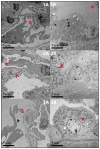Progressive glomerular and tubular damage in sickle cell trait and sickle cell anemia mouse models
- PMID: 29476712
- PMCID: PMC6003843
- DOI: 10.1016/j.trsl.2018.01.007
Progressive glomerular and tubular damage in sickle cell trait and sickle cell anemia mouse models
Abstract
Homozygosity for the hemoglobin (Hb) S mutation (HbSS, sickle cell anemia) results in hemoglobin polymerization under hypoxic conditions leading to vaso-occlusion and hemolysis. Sickle cell anemia affects 1:500 African Americans and is a strong risk factor for kidney disease, although the mechanisms are not well understood. Heterozygous inheritance (HbAS; sickle cell trait) affects 1:10 African Americans and is associated with an increased risk for kidney disease in some reports. Using transgenic sickle mice, we investigated the histopathologic, ultrastructural, and gene expression differences with the HbS mutation. Consistent with progressive glomerular damage, we observed progressively greater urine protein concentrations (P = 0.03), glomerular hypertrophy (P = 0.002), and glomerular cellularity (P = 0.01) in HbAA, HbAS, and HbSS mice, respectively. Ultrastructural studies demonstrated progressive podocyte foot process effacement, glomerular basement membrane thickening with reduplication, and tubular villous atrophy with the HbS mutation. Gene expression studies highlighted the differential expression of several genes involved in prostaglandin metabolism (AKR1C18), heme and iron metabolism (HbA-A2, HMOX1, SCL25A37), electrolyte balance (SLC4A1, AQP6), immunity (RSAD2, C3, UBE2O), fatty acid metabolism (FASN), hypoxia hall-mark genes (GCK, SDC3, VEGFA, ETS1, CP, BCL2), as well as genes implicated in other forms of kidney disease (PODXL, ELMO1, FRMD3, MYH9, APOA1). Pathway analysis highlighted increased gene enrichment in focal adhesion, extracellular matrix-receptor interaction, and axon guidance pathways. In summary, using transgenic sickle mice, we observed that inheritance of the HbS mutation is associated with glomerular and tubular damage and identified several candidate genes and pathways for future investigation in sickle cell trait and sickle cell anemia-related kidney disease.
Copyright © 2018 Elsevier Inc. All rights reserved.
Conflict of interest statement
All authors have read the journal’s policy on conflicts of interest and there are no conflicts of interest to disclose.
Figures






References
-
- Guasch A, Navarrete J, Nass K, Zayas CF. Glomerular involvement in adults with sickle cell hemoglobinopathies: Prevalence and clinical correlates of progressive renal failure. J Am Soc Nephrol. 2006;17(8):2228–2235. - PubMed
-
- Platt OS, Brambilla DJ, Rosse WF, et al. Mortality in sickle cell disease. Life expectancy and risk factors for early death. N Engl J Med. 1994;330(23):1639–1644. - PubMed
Publication types
MeSH terms
Grants and funding
LinkOut - more resources
Full Text Sources
Other Literature Sources
Medical
Miscellaneous

